Skip down to:
Prerequisites
All course participants must have the following experience before attending:
- Review SIM Section 6–8
- USPA C-license (can be earned at AXIS Flight School)
- 200+ jumps and current
- At least 50 jumps on the equipment you intend to use with camera equipment (i.e. rig, canopy, etc.)
Please contact Niklas Daniel at info [at] niklasdaniel.com.
Find his photography website at NiklasDaniel.com.
Introduction to Camera Flying
Cameras are vital to our sport, as they help us learn greater levels of skill, and share our unique experiences with the world, which go unnoticed on the ground.
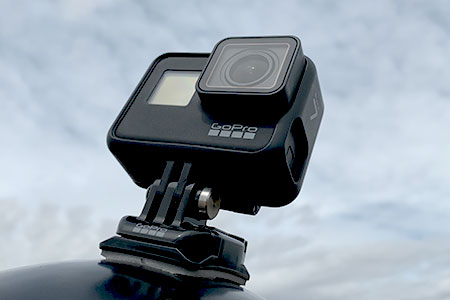
Photo by Niklas Daniel.
Unlike an AFF or Tandem Instructor, who needs to qualify and earn a rating to be hired by a reputable school, there is no "camera rating" within the sport. The USPA and other organizations have come up with some general ideas as to what qualifications a beginning camera-flyer should have, but most of these items are only recommendations and not a set training curriculum. Strapping on a camera to your head is not to be taken lightly. Proper training and introduction to the craft is vital for your own safety, as well as your subjects. Even though cameras are getting smaller and lighter each year, flying with a camera is a serious decision and it requires additional effort and attention on each jump.
By taking on the unique challenges of becoming a camera flyer, you will be able capture memories and express yourself creatively.
Once a camera flyer has become established as having demonstrated great skill, and a reliable product, it is possible to make the transition from amateur to professional. By building a portfolio, a camera flyer can start charging for services and applying to competition teams and Skydiving Schools.
Camera Wings
To be a more effective and maneuverable, many camera flyers resort to additional equipment to set them up for success.
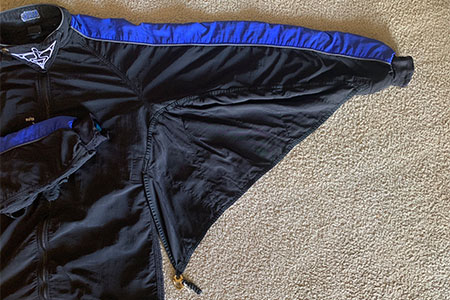
Photo by Niklas Daniel.
Camera wings are a great addition to your kit, especially when filming horizontally oriented subjects, such as Tandems, AFF students, and or Formation Skydiving (FS) Teams. Wings are frequently seen on camera-flyers at skydiving schools, competitive events, records, boogies, and film productions. Wings can provide increased stability to your flying (like a tripod), give you greater fall rate range, and provide you with additional surface area when flying through burbles.
Competition and Large Formation Videographer
Filming a team (either for a weekend, or professionally) is a big responsibility and not to be taken lightly.
Your actions and decisions do not just affect the judging process, but safety as well. In order to get the best shot for scoring, the camera flyer needs to frequently position him or her self in a precarious position that can affect the team’s performance and safety.
Formation Skydiving
In the FS disciplines, the camera flyer is above the performers in order to capture each formation, which later gets submitted to the judges on the ground.
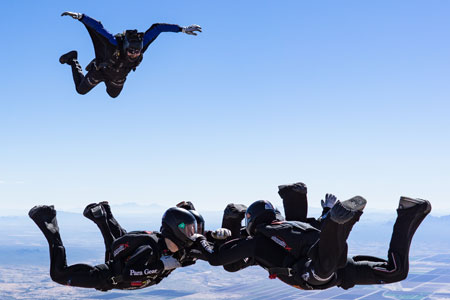
Photo by David Wybenga.
Niklas Daniel filming FS 4-way team Arizona Airspeed.
Though the above vantage point is best to effectively capture all the action, it is also a potentially dangerous position to be in, in the event you get caught in the team’s burble and are unable to recover. Collisions must be avoided at all cost, which can cause severe injuries and premature deployments of the main or reserve. Therefore much of the training focuses on exits skills, spatial awareness, and flying ability.
Free-flying
In the VFS discipline, the camera flyer’s best vantage point for capturing the action is from below.
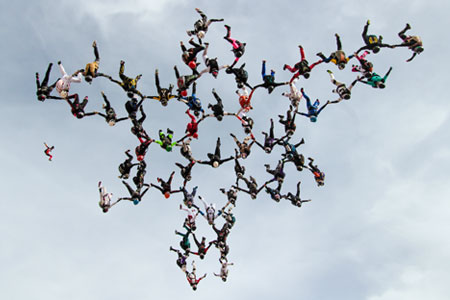
Photo by Niklas Daniel.
Women's Vertical World Record 63-Way.
Therefore s/he must be aware of the burble being presenting towards the performers above. In addition safe gear practices must be implemented to prevent a premature deployment that could jeopardize the entire team.
Tandem & AFF Camera Flyer
Capturing someone’s first, and possible only skydive in life, is an important responsibility and rewarding.
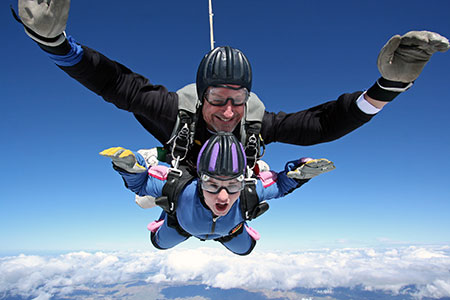
Photo by Niklas Daniel.
In order to do so properly, the experienced camera flyer must be able to take quality video as well as photographs that meet professional grade expectations. This process has to be repeatable and on demand.
Available Merits
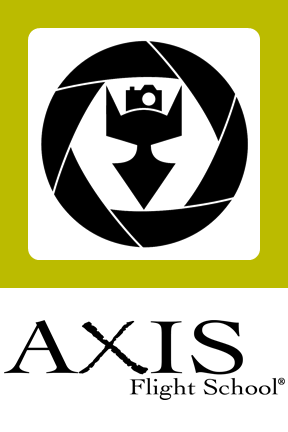
Introduction to Camera Flying
Recipient has demonstrated the knowledge and skill to fly with small action cameras.
How this Merit is Earned
Achieved prerequisite merits: Belly Flyer Tunnel and Belly Flyer Sky.
In addition, recipient has demonstrated the following to the satisfaction of an AXIS Coach™:
a) Reading of SIM Sections 6-8 before the course. b) Has a USPA C-License. c) Logged 200+ jumps. d) Competence in the execution of prescribed exercises. e) Camera flying specific emergency procedures. f) Climbing on to the camera step. g) Construction of a helmet. h) Using a sighting tool. i) Basic video camera settings.

Camera Wings Endorsement
Recipient has demonstrated the knowledge and skill to fly with camera wings.
How this Merit is Earned
Achieved prerequisite merits: Belly Flyer Tunnel, Belly Flyer Sky, and Introduction to Camera Flying.
In addition, recipient has demonstrated the following to the satisfaction of an AXIS Coach™: a) Competence in the use of wings in the wind tunnel. b) Competence in the use of wings in the sky. c) Emergency procedures specific to flying with wings.

Formation Skydiving Camera Flyer
Recipient has demonstrated the knowledge and skill to film FS teams.
How this Merit is Earned
Achieved prerequisite merits: TunnelBelly Flyer, Sky Belly Flyer, Introduction to Camera Flying, and Camera Wings Endorsement.
In addition, recipient has demonstrated the following to the satisfaction of an AXIS Coach™: a) Captured 10 consecutive, judgeable and debriefable videos without error for 4-Way FS, b) Can utilize leading and peeling exit shooting techniques, c) Above average flying ability, d) Awarenes of safety concerns in the air.
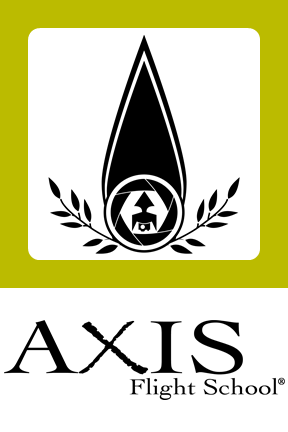
Vertical Formation Skydiving Camera Flyer
Recipient has demonstrated the knowledge and skill to film MFS and VFS teams.
How this Merit is Earned
Achieved prerequisite merits: Tunnel Belly Flyer, Tunnel Back Flyer, Tunnel Head-up Flyer, Tunnel Head-down Flyer, Sky Belly Flyer, Sky Back Flyer, Sky Head-up Flyer, Sky Head-down Flyer, Introduction to Camera Flying.
In addition, recipient has demonstrated the following to the satisfaction of an AXIS Coach™: a) Captured 10 consecutive, judgeable and debriefable videos without error for 4-Way VFS or 2-way MFS, b) Can utilize leading and peeling exit shooting techniques, c) Above average flying ability, d) Awarenes of safety concerns in the air.
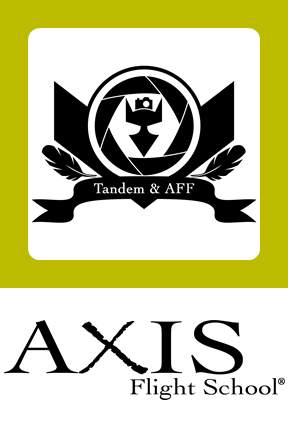
Tandem & AFF Camera Flyer Proficiency
Recipient has demonstrated the knowledge and skill to film tandems and AFF students.
How this Merit is Earned
Achieved prerequisite merits: BellyFlyer Tunnel, Sky Belly Flyer, Introduction to Camera Flying, Camera Wings Endorsement merits.
In addition, recipient has demonstrated the following to the satisfaction of an AXIS Coach™: a) Video portfolio of various group jumps in the belly orientation, b) Knowledge of still camera settings and lens options, c) Shooting techniques specific to school work, d) Awarenes of safety concerns in the air.
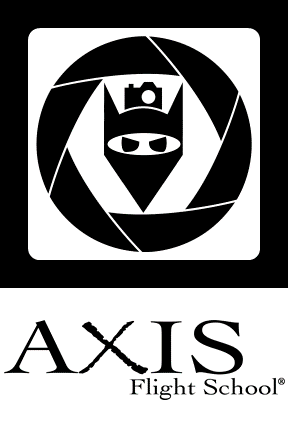
Camera NINJA
Recipient has demonstrated extraordinary flying ability and contributes to the sport of camera flying by teaching others.
How this Merit is Earned
Achieved merits: Introduction to camera flying, Camera Wings Endorsement, Formation Skydiving Camera Flyer, Vertical Formation Skydiving Camera Flyer, and Tandem & AFF Camera Flyer.
In addition, recipient has demonstrated the following to the satisfaction of an AXIS Coach™: a) Competed as a videographer at a FAI Category 1 Event, b) Participated as an outside videographer on a World Record, c) provided outside video for larger formations in both FS and Free-fly disciplines, d) Photography publication on the cover of a magazine.

